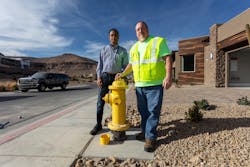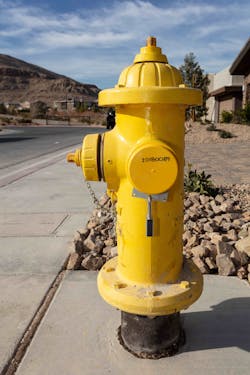Las Vegas Valley Water District Uses Sensors and Modeling Technology
The Las Vegas Valley Water District (LVVWD) is the largest retail water utility in southern Nevada.
Serving about 1.6 million people in residential and business sectors throughout the city of Las Vegas and areas of unincorporated Clark County, the system consists of more than 6,000 miles of pipeline and service laterals, 24 active pressure zones, more than 40 reservoirs and more than 50 pumping stations that help move the water from the Southern Nevada Water Authority throughout the valley, lifting the water about 2,000 feet to reach the entire service territory.
A 24-hour town, Las Vegas is home to businesses and residents that depend on consistent, quality water service at all hours of the day, 365 days a year. As a service provider for one of the fastest developing communities in the United States, LVVWD has for decades taken a proactive, forward-thinking approach to growing and maintaining its water system.
Spurring New Technology into Action
In early 2000, LVVWD began to implement hard download pressure sensors for monitoring its water system. With this technology, the utility was able to collect pressure data to help maintain and operate its infrastructure, but it wasn’t the most efficient system possible, since staff would have to go out in the field to manually and regularly collect the data.
It wasn’t long until LVVWD realized the need for wireless sensor technology to allow for remote monitoring and real-time collection of data. The problem was that no one was producing this technology yet. In 2006, LVVWD approached Telog Instruments (now part of Trimble Water) requesting sensors with wireless capability. Telog saw the benefit, and within a few years began manufacturing wireless data loggers that LVVWD started using.
“One of the nice things is when, as a utility, you are able to work with a vendor that can be responsive to your needs, that is open to your feedback, so that they can optimize the level of service they're providing, and we can optimize the level of service we're providing to our customers,” said Bronson Mack, public information officer at LVVWD. “When you can have those kinds of partnerships, it is really beneficial—not just to us as a utility, but ultimately to the water industry as a whole.”
Combining sensor pressure data with modeling technology, LVVWD keeps its infrastructure planning and management ahead of the curve.
Wireless Sensors Streamline Processes
Today, LVVWD uses 18 wireless pressure recorders. With a wireless system, the utility is now able to get data much more efficiently than if they had to go out to individual devices themselves, download the needed information and bring it back to the office for analysis.
“We just deploy them and immediately start getting information into our computers in our office,” said Sri Kamojjala, senior civil engineer with LVVWD.
Bill Turner, LVVWD Senior Engineering Technician, said they move the sensors around to different locations as needed, which is made easy by how fast they are to install. Placing one of the recorders takes just about five minutes, he said. These sensors are simply fixed onto a fire hydrant and then begin wirelessly monitoring and communicating water pressure levels to LVVWD.
Kamojjala says wireless sensors are especially helpful during an emergency response, where getting data in real time can help the utility see where action is needed immediately. He recalls one occasion where a contractor drilled into the utility’s pipe, which could have been a huge problem leading to a large-scale water service interruption for customers. But since LVVWD develops a pumping plan each day with its modeling technology, their operators knew exactly how the system was running and were able to reconfigure the plan and successfully divert water to customers within just two hours. Ultimately, nobody ever knew about the issue aside from the contractor and LVVWD.
“Being able to quickly and nimbly reroute water through our system—either through valve operations or other configuration changes that we can make to minimize that service outage area—really is a huge benefit to us and our credibility,” Mack said.
Maximizing Benefits
The technology can also contribute to a positive impact on the environment, reducing the carbon footprint that comes with sending trucks out to the site for data collection. “It's a better, efficient use of rate payer dollars, and that also aligns with our sustainability goals to minimize greenhouse gas emissions,” Mack said.
This technology helps LVVWD balance its three core functions as a utility, according to Kamojjala.
“If you take any utility, or any business for that matter, you have three functions. One is the asset management, or taking care of existing assets. The second is taking care of the customers, or operations. And then the third is taking care of new customers, or system growth. So we need to integrate all of these three functions,” he said.
For LVVWD, system growth is an especially key concern, with its service area being one of the fastest growing communities in the country and new development adding to the needs of the water system.
“This modeling activity really helps to ensure that any additions to our water system, any expansion of our water system, does not affect service to existing customers,” Mack says. “That’s paramount for us.”

